 |
| |
 |
|
STORING
COMIC BOOKS -
KEEP
CALM AND KNOW THY ENEMY
|
|
|
|
| |
| A 6th century BC Chinese
general, Sun Tzu authored an immensely influential book
on military strategy which today is best known in the
West as Sun Wu, the "Art of War".
Possibly one of the best known maximes put forward by Sun
Tzu is often quoted as "know your enemy". Not
taking into account the many philosophical undertones the
actual passage contains, it has become a nifty way of
saying: if you do something, be aware of why you are
doing it and what for. This is, of course, just as true when
it comes to storing comic books, where there is a current
mainstream consensus that "bagging and
boarding" a comic book is the way to go for safe
storage. But what exactly is everybody protecting their
comic book against? Do they know their collection's true
enemy?
|
| |
| In the
1970s, the average comic book reader would probably keep
his comics stacked in a simple pile somewhere. Although
still seen today, the average comic book reader is now
also an accidental comic book collector who handles and
stores his individual comics with at least a certain
amount of care. |
| |
| The "traditional"
loose stack has many disadvantages, the most
obvious being that because the spine side of a
comic book is thicker (accentuated by the two
staples used to hold the comic book together)
this can create a lopsided "U" which
will eventually roll the individual comics into
the very same shape (hence the term "spine
rolling"). The change of attitude in the
average comic-book-reader-turned-collector has
become so pronounced that it has in fact more or
less completely altered the traditional view of
comic books. Originally seen as a prime example
of ephemera (transitory printed matter
which, as the Greek noun describes, lasts no more
than a day and is not intended to be retained or
preserved) just the same as newspapers (a
parallel underscored by the use of the cheapest
grade of paper for both), comic books are now
understood to be items worth storing with care,
i.e. collectibles, rather than a disposable
commodity.
For
many, the question therefore is not whether
or not to think about storing comic books or
not, but rather how to store them. This
is mainly because virtually all published
information on storing comic books kicks off with
the bad news that any pre-1990s comic book is in
a process of deterioration since the
moment it went into circulation, due to the
acidity of the low-grade paper (known as newsprint)
used to print comic books prior to the early
1990s.

|
|


|
|
| |
| If the situation truly is
as bad as many expert collectors tell their audience,
then surely knowing exactly what kind of dangers comic
books face is imperative. |
| |
COMIC BOOK ENEMY NUMBER ONE:
PHYSICAL DAMAGE
|
| |
| The main
threat to comic books still is what it always used to be:
raw physical damage. Paper is a vulnerable material which
provides very little resistance and is thus easily
deformed or even torn, and the covers and interior pages
of a comic book will soon suffer if they are exposed to
excessive and/or careless handling. Unlike damage which
is triggered by chemical processes, physical damage is
usually instant, and the major element making comic books
so prone to physical damage is their relative
instability: they are usually thin (which offers little
or no resistance to disformation) and held together only
by two staples.
|
| |
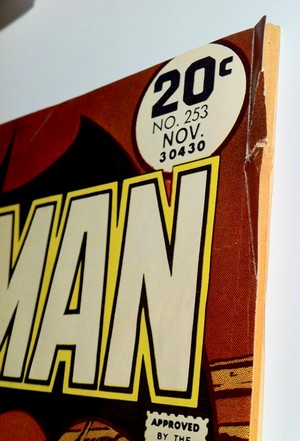 |
|
The copy of Batman
#253 illustrated here has suffered from such
purely physical damage: the corner of the cover
has been both creased and bent and then torn and
ripped through handling - a commonly known defect
in comic books and a typical sign of a certain
age (and therefore extended tear and wear). This kind of
very direct physical damage is most often also
inflicted by direct handling of a comic book.
Another important source of physical damage is
humidity - whilst sometimes less apparent, it is
nonetheless just as permanent as a nick or a
tear.
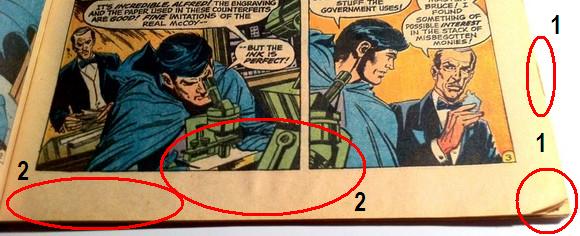
|
|
| |
| Whilst the
circled areas numbered "1" of this page from Batman
#253 show the already mentioned physical damage afflicted
by careless handling (scuffed and ragged edges and bent
corners), the circles numbered "2" show the
damage done by humidity. In this specific case, the paper
has started to curl slightly and displays the
"wave" which typically occurs when paper comes
into contact with e.g. water (right hand circle) whilst
also displaying the stains (left hand circle) which
remain when the paper has dried again. Although contrary to
the effects of direct physical impact the damage
inflicted by excess humidity can to acertain degree be
reversed (as per the emergency drying procedure suggested
by the Library of Congress), the fragility of
comic books (especially pre-1990) and the high absorbency
rate of the paper used in their printing usually results
in substantial damage - which can turn into a complete
loss if exposure to humidity is high and prolongued as
this will turn a comic book into a breeding ground for
mould.
It is fairly
obvious that in order to minimise the risk of direct
physical damage, individual comic books need to be
strengthened in terms of material stability and protected
from physical impact. The now standard method of storing
each comic individually in a protective see-through
sleeve into which a cardboard backing board is inserted
makes sense: it adds rigidity to the comic book and
protects it from all but the most massive bending forces.
As far as damage through humidity as well as soiling
goes, the sleeve (mostly made from polyethylene and
polypropylene) acts as a barrier, which when combined
with sensible storage (i.e. avoiding spaces which are
damp or prone to flooding) keeps dirt and humidity at
bay.
|
| |
| However, there is one form of
direct physical damage which protective sleeves
can only slow down at best but not prevent: the
attack by animals. Admittedly a far less frequent
source than tear and wear or humidity, insects
can do a surprising amount of damage - although
this is nothing compared to what rodents can do
to a comic book (or, as a matter of fact, any
paper product). The example shown here
illustrates the rather peculiar and therefore
easily identifiable damage rodents inflict (also
known as mouse or rat "chew")- they
literally take a bite out of your comic book, as
the tooth markings on the spine and the
indentations on the back cover of this copy of Superman's
Pal Jimmy Olsen #161 clearly show.
Incidentally, this comic book came from a sealed comic pack, showing
that plastic is neither a deterent nor a barrier.
As the copy of Batman #253 used as
illustration above was packaged together with Superman's
Pal Jimmy Olsen #161, the humidity damage
seen on the Batman issue could also be linked to
the rodents - not a very nice possibility, which
also illustrates that direct and indirect
physical damage can degrade a comic book to the
point where it once again turns into a piece of ephemera
- i.e. something which is best thrown away.
|
|
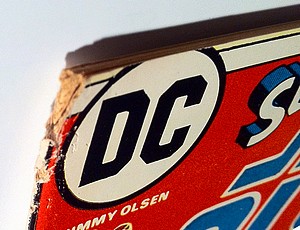 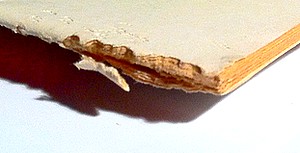
|
|
| |
| An aspect not mentioned too
often is the odour some comic books have taken on over
the years. If stored in a smoking household, an otherwise
(i.e. visually) well preserved comic book may have
acquired a smell which is both unpleasant - and permanent
in most cases. Again, plastic sleeves can act as
barriers, but only to a certain point, as they will never
be airtight. It is also interesting to note that there
are several reports on the web that comics can be highly
odorous even from inside a CGC slab casing. |
| |
COMIC BOOK ENEMY NUMBER TWO:
LIGHT
|
| |
| The most widely discussed
storage problem associated with comic books is the
degradation of paper linked to its inherent acidity.
However, this comic book enemy is not only often portrayed in
wildly exaggerated ways, but also describing and taking
the effects to be the cause - a classic case of mistaking
the enemy. It is now common knowledge that the
paper used for printing comics was (up until the
mid-1990s) of inferior quality; generally known and
refered to as newsprint, it was used primarily
for its low cost factor and its high absorbency, which
was well suited to rubber plates used on high-speed
offset presses.
|
| |
 |
|
The drawback of the
production process of newsprint paper is
the fact that it results in very short
fibres and high levels of lignin (which is a natural bonding
element in plants that holds the wood
fiber together but gives off acids as it
deteriorates). This
combination triggers rapid discolouring
and oxidising (the paper turns brown),
and also sets free acids which degrade
the paper material even further - also a
major concern for many books printed
since 1850 (and most definitely so for
mass market paperbacks from the 1970s). However,
the acidity (although built-in to the
comic book) is only the catalyst, i.e. it
requires a triggering agent to do its
damage, which will then either result in acid-catalysed
hydrolysis or oxidation.
|
|
|
| |
| Acid hydrolysis breaks the
molecule chains and weakens the fibres, causing paper to
become hard and brittle. Of far greater concern to comic
book collectors (and hence the storage of their
collectibles) however is acid oxidation which discolours
the paper and makes it take on a yellow or even brownish
colour. Both the cellulose (and its derivatives) and the
lignin contained within the paper can be oxidised, but it
is the lignin that is the main cause of photo-yellowing
of paper (Seery, 2013). |
| |
| Lignin
has a chemical setup (specific chromophores and
carbonyl groups) which absorbs light in the near
ultraviolet (UV) spectrum of light. When this
happens, these chromophores decompose into
yellow-coloured ketones and quinones, i.e. they
turn the paper yellow. However, since these
yellow-coloured molecules themselves absorb
visible light, they also act as secondary
chromophores and can react even further, adding
to the yellowing and degradation processes
(Seery, 2013). This
makes it clear that the presence of light is more
important than the presence of lignin and other
acidic elements in terms of paper degradation -
which occurs because light is radiant energy that
causes irreversible change through its output of
chemical energy and the resulting photochemical
reaction.
The most potent
source of this destructive energy comes from just
beyond the limits of the visible spectrum of
light, as ultraviolet rays (with their shorter
wavelength and thus higher energy rate) are
especially harmful and a significant catalyst for
photochemical destruction.
The problem is that
UV light is not only present in all daylight (and
most abundantly in direct sunlight) but also in
many fluorescent and metal halogen lamps.
|
|

(scienceinschool.org)

|
|
| |
| There is some overlap in
the forms of deterioration caused by visible light and
UV, but as a generalization exposure to visible light
causes fading and bleaching of colours in paper, whilst
UV causes the yellowing (Vávrová, Kotlík, Durovic
& Brezová, 2011) - the different types of damage
typically caused are the result of the different photon
energies of UV and visible light (Michalski, 2013). |
| |
 |
| |
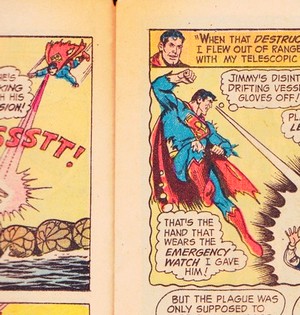 |
|
Fading
mostly occurs on comic book
covers when stored in conditions
which subject them to direct (and
often prolongued) exposure to
sunlight (as illustrated above). If the comics
were stacked, this can result in
the typical fading patterns found
when only a certain part of the
cover was exposed whilst the rest
was covered by the comic book
lying on top.
Browning
will always occur predominantly
on surfaces which are highly
exposed to light, i.e. the edges.
This is where the oxidation
process is initiated, but with
subsequent "bleeding"
into interior areas once the
photochemical processes take
place. This often runs along the
spine but can ultimately befall
the entire page(s).
A
chemical catalyst which can be
the result of handling is lactic
acid. As a component of human
sweat, this can be transferred to
paper surfaces during handling.
and although a weak acid this can
contribute to the deteriation.
|
|
|
|
| |
COMIC BOOK
STORAGE AND PROTECTION:
KEEP CALM
|
|
| |
| Having identified the two
main enemies which comic books are up against if simply
left lying about, it is now time to think about adequate
measures to fight those enemies. It is also, however, a
good and sound advice to stay calm about this. Why? Because having undergone the
magic transformation from disposables to collectibles,
comic books have also become the focus of attention of
the collectibles market - a highly constructed
environment which is as much about a hobby as it is about
making money (cf. THOUGHT BALLOON #34). One of the most important elements
which operates any collectibles market is the condition
of an object (usually referred to as "grade")
in conjunction with scarcity. In other words: collectors
will usually prefer items in excellent condition to items
of a lesser grade, and the fewer well-preserved objects
available the higher the price which a collector can be
expected to pay for it.
Combined with the fact that
the world wide web is a marketplace as much as it is an
information hub, this explains why so much information to
be found on the internet today on comic book storage
is actually, to all intent and purpose, concerned with
long term comic book conservation. The
difference may appear subtle at first sight, but in
reality the two concepts are fundamentally different.
Whereas storing comic books is an attempt to prevent
major damage and degradation and thus preserve them in
the best shape possible (i.e. accepting a few minor
tell-tale signs of its actual age), conservation is aimed
at preserving a comic book in its current material state,
or in other words "freezing" the current
condition for posterity.
In practical life, this
difference draws the line between a collector and an
archival museum - unless, that is, conservation is seen
as a means of safeguarding and possibly raising a
collectible's monetary value for future sales
(ultimately, this approach to conservation may even bleed
into restoration of comic books, which if used
in conjunction with the intention to sell is frowned upon
by most).
The speculative nature of
the collectible's market has thus permeated information
on storage and maintenance of comic books to the point
where the differing priorities of collectors and
speculators often become blurred and confused. The
resulting advice given to "all collectors" is
more often than not over the top, simply because most
collectors with no speculative investment interest will
accept some minor degradation occuring after 30+ years,
whereas a perfect grade conservation guarantee up to the
year 2100 only makes sense if later generations are taken
into account. However, even the idea of leaving behind a
profitable inheritance - again planted by the forces
which drive the speculative collectibles market - is made
questionable by the simple fact that almost any comic
book published since 1990 will be in excellent supply
both in terms of numbers and grade for decades to come
(cf. THOUGHT BALLOON #34).
Sometimes the advice found
on comic book storage makes it seem as though a large
percentage of comic book collections worldwide is just
about to turn into brown crumbles and heaps of dust. Keep
calm - that isn't so.
|
| |
COMIC BOOK
STORAGE AND PROTECTION:
BAGS AND BOARDS
|
|
| |
| As
mentioned, minimising the risk of physical damage to
comic books is easy - by simply strengthening individual
issues by inserting them in a protective sleeve into
which a cardboard backing board is inserted: a well
established best practice commonly known as "bagging
and boarding". |
| |
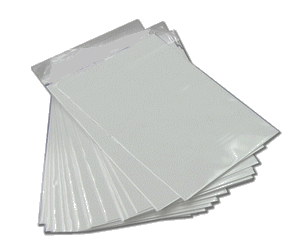 |
|
The variety of products
offered and on sale is enormous, but the most
commonly used materials are polyethylene and
polypropylene. Both of these materials are
manufactured with solvents and additives which
break down over time, causing some experts to
point out that only uncoated polyester film
(known as Mylar[R]) will remain
stable - however, all three of the mentioned
materials have accepted photo activity test
ratings which make them safe for long-term
storage (Teygeler 2004). Polyvinylchloride (PVC)
however should be avoided, as it can break down
into hydrochloric acid over time. All types of plastic bags
have their own inherent problems: they can trap
moisture (which may lead to mold growth), their
static electricity can lift fragile, flaking
surfaces, and plastic doesn’t provide any
buffering protection against changes in humidity
like paper can.
|
|
| |
| This
latter aspect is another point in favour of
backboards in general and acid-free backboards in
specific, as nobody will want to add to the
inherent acidity in the paper. However,
"acid-free" signifies "at the time
of manufacture"; any pronounced level of
acidity in a comic book will eventually
"bleed" into the backboard. Possibly the
most effective method of maintaining a comic book
collection therefore are regular checks, which
ultimately are more important than chosing the
best archival-safe materials. Looking through the
collection on a regular basis will reveal any
possible problem in its beginning stages, before
substantial damage has occured.
The
real question now is - hardly ever raised in
conjunction with the advice to bag and board
comic books - whether or not it is sensible to
apply this storage measure to all comic
books in a collection.
Obviously,
comic books which are known or believed or hoped
to be worth a lot of money now or any time in the
future should be carefully bagged and boarded -
and then stored in a bank vault.
Sentimental
importance and nostalgia is a valid criteria for
any collector to store certain items with special
care. For these comic books, bagging and boarding
may make sense.
For
the remainder of a comic collection it is at
least worth pointing out that not
boarding and bagging a comic book does not
automatically make it doomed - especially
post-1995 comic books, which are either printed
on acid free paper (in line with a 1989
commitment by major US print publishers to
utilizing ISO 9706 certified permanent durable
paper) or on high quality glossy paper which has
been chemically de-pulped and coated with an
alkaline buffer to better protect against
environmental pollutants that cause acid
hydrolysis (Teygeler 2004). Generally speaking,
better paper quality goes hand in hand with a
more sturdy product which is less prone to tear
and wear, although there can be huge differences.
The current single issues from Marvel are at
times printed on paper so thin that they can be
even flimsier than Bronze Age examples, whereas
DC has even started to use thicker grade paper
(almost cardboard) for their covers in 2014.
Archie Comics and Boom Studio have a similiar
setup, and Dynamite uses fairly heavy paper stock
throughout.
Bagging and boarding
each and every comic book in a collection is not
only a cost factor, it also adds two new
collections to the comic books: one is plastic
bags, the other backing boards - and both take up
space.
|
| |
|
COMIC BOOK
STORAGE AND PROTECTION:
LIGHTS OUT
|
|
| |
| Polybags
and backboards will protect comic books against physical
damage, but not against chemical degradation. The most
important element to shy away from, as mentioned before,
is light. |
| |
| This makes it a logical
conclusion that comic books should be stored in a
dark place. The traditional storing
method addressing this need is the "long
box" or the "short box", a
standard strong cardboard box which holds comic
books in an upright position. Using these boxes,
comic books can be stored in the dark, which
counteracts the main degradation source. Again,
acid-free cardboard boxes are available from
specialist sources.
Container
devices used to store individual comic books in
one place should not only provide an environment
which is protective of light, they should also
have a certain stability and be able to withstand
a few undeliberate knocks. Although the stability
of long or short boxes is probably underestimated
by many, cardboard does have its limitations over
time, especially when several boxes need to be
stacked. Outward appearance, although completely
irrelevant with regard to storage quality, also
plays a part in many collectors looking for and
turning to other solutions with more durable
materials.
|
|

A typical example of a comic
books short box (in this case from the Miller
Hobby brand of comic book storage
boxes)
[image is (c) Miller Hobby,
used with kind permission]
|
|
| |
| It should be mentioned that
exposure to light continues to have a degradation effect
to a certain degree even during subsequent dark storage -
a phenomenon known as post-irradiation effect (Vávrová,
Kotlík, Durovic & Brezová, 2011). This also
illustrates a fundamental dilemma: light is the main
source of degradation to comic books, yet it is required
to read and enjoy them. UV filters could be an option,
although hardly worth the effort for most items in an
average collection. In
addition to dark storage, the American Institute for Conservation
of Historic & Artistic Works advises to keep paper objects in a
cool and dry environment, ideally maintaining a
temperature below 72 degrees Fahrenheit at a relative
humidity of between 30 percent and 50 percent. Climatic
fluctuations cause papers to expand and contract, and
warm or moist conditions should be avoided, for the
reasons given above.
Bagged and boarded comic
books are generally stored in an upright position. There is, however,
ample and informed information available which dispells
the myth of the absolute imperative for vertical storage.
The Northeast Document Conservation Center (a non-profit
regional conservation center in the United States,
founded in 1973 and counting amongst its clients the
Boston Public Library and Harvard University) advised
that although vertical storage in office files or in
upright flip-top archival document storage boxes is
acceptable for legal-sized or smaller documents, any
objects larger than 15" x 9" should be stored
flat. This is due to the pull forces which documents
stored in an upright position are subject to, and it is
safe to assume that what is best practice for larger size
documents works out well for comic books as well.
|
| |
CONCLUSION:
KNOW THY ENEMY, KEEP
CALM & DO IT YOUR WAY
|
|
| |
| There
obviously are huge differences between individual
comic book collectors, and these differences
spill over into just what kind of comic book
collections these individuals call their own,
both in terms of numbers and age of the
individual comic books. The approaches to storage
may therefore also differ, for reasons easily
understood. One thing, however, remains a
constant: the maintenance of any collection
should be done sensibly. Counteracting, for
example, the use of acid-free backboards with the
use of acidic storage boxes not only defies the
logic but the actual goal of the exercise. It may
also be that not all individual comics from a
collection merit elaborate storage, and regrets
twenty, thirty years from now for having picked
the wrong titles for "basic" storage
(when all of a sudden the sentimental value of Zapman
issues outweigh those of the Batman
comics, even though it was completely the other
way round at the time) should not be too harsh as
any comic book stored subject to a small set of
best practice rules should remain in more than
just acceptable condition. The following
advice from the Shiloh Museum concerns
photographs, but poses questions just as valid
for comic books:
"Storing photos
properly is expensive and time consuming.
Before you start, determine if all of your
photos are worth the effort. Ask yourself:
which photos should be considered heirlooms?
which are poor quality or redundant? which
are the most fragile?"
It really is quite basic -
individual comic books should be stored in a
cool, dry and - most importantly - dark
environment. Everything else, such as protection
from soiling, protection from "acid
leaking" from other material containing wood
pulp, protection from other pollutants or
protection from soiling or insects is really up
to the individual collector and his individual
storage situation and needs.
|
|
| |
| |
| References MICHALSKI
Stefan (2013) Agent of Deterioration: Light,
Ultraviolet and Infrared, Canadian
Conservation Institute
SEERY
Michael (2013) "Savin paper", in Education
in Chemistry, March 2013, 23-25
TEYGELER
R. (2004). Preserving paper: Recent advances, in
J. Feather (Ed) Managing preservation for
libraries and archives: Current practice and
future development, Ashgate Publishing
VAVROVA
Petra, Petr Kotlík, Michal Durovic & Vlasta
Brezová (2011) "Damage to Paper Due to
Visible Light Irradiation and Post-Radiation
Effects after Two Years of Storage in
Darkness", in New Approaches to Book and
Paper Conservation-Restoration, Patricia
Engel et al. (eds), Verlag Berger
|
|
| |
First
published on the web 9 March 2010
Completely revised and updated 19 July 2014
|
| |
Content is (c) 2010-2014 A. T. Wymann
|














